Students Raise Awareness of Nonprofits Through Emerson LA VR Class
In the virtual reality film A Different Lens: An Immigration Story, Emerson students Leilani Thomas ’18 and Samantha Mustari ’18 profile the life of one of their classmates, Albert Rano ’19, who was born and raised in the Philippines. The nearly five-minute VR film shows a day in Rano’s life as he goes around Los Angeles capturing what he experiences with a video camera.
“Everybody’s immigration story is different,” said Mustari, who worked with Thomas on every aspect of the film, from the concept and directing to the editing and music. “It was really cool. We had a lot of creative freedom.”
Mustari and Thomas created the film in collaboration with Brookline Interactive Group, an integrated media and technology education center that helps facilitate diverse community dialogue and storytelling. The film was created as part of the Virtual Reality for Social Change course at Emerson College Los Angeles. Through the course, groups of students partnered with LA nonprofits and created projects to raise awareness for social causes and advance the missions of the organizations.
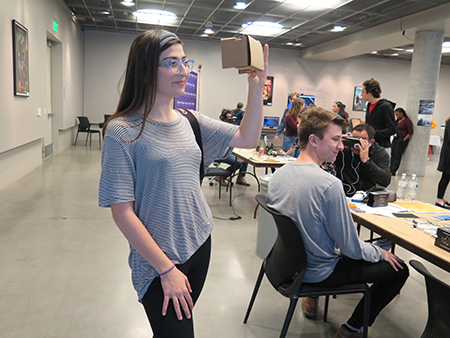
Samantha Mustari ’18 plays with a Google Cardboard headset during a showcase at Emerson College Los Angeles. Photo/Daryl Paranada
“The power of VR is very much in the personal and being in a person’s life,” said alumna Sarah Berkovich ’10, who taught the course. “The general public still isn’t very aware of this technology. We’re helping educate the community and bringing them in.”
The other nonprofits that the class partnered with include Coro, which trains ethical, diverse civic leaders nationwide; Film2Future, which empowers underprivileged, at-risk LA high school students to value and share their unique creative perspectives; and Outfest Los Angeles, which promotes LGBTQ equality by creating, sharing, and protecting LGBTQ stories on the screen. On April 26, the students presented their work during a showcase.
Max Devolder, manager of VR at Legendary Entertainment, was among the guests present for the showcase.
“[The class] sounded very innovative and impactful,” said Devolder. “I’m looking forward to what the students have to present.”
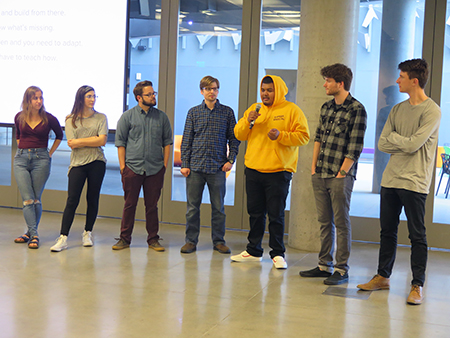
Virtual Reality for Social Change course listen as Andrew Arias speaks about his experience working on the project. Photo/Daryl Paranada
Berkovich's class is one of two inaugural engaged courses that ran at Emerson LA this past semester. Through engaged courses, students and nonprofit partners form mutually-beneficial relationships through which they pool their resources in order to help meet needs identified by the nonprofits. The projects in this course were supported by a $1,000 Service Learning Innovation Grant that Berkovich was awarded from the Elma Lewis Center for Civic Engagement, Learning, and Research (ELC). The grant funded the purchase of VR gear that was donated to the nonprofits so they can continue using the tool to empower their clients to tell their own stories.
“Virtual reality's capacity to increase viewer empathy makes it a powerful tool for advancing social justice,” said Suzanne Hinton, the ELC's director of academic engagement and administration.
For a nonprofit like Coro, one of the challenges was explaining to the public what it does. In their film, Tim Howard ’18 and Ben Yumakas ‘18 feature voices talking about Coro while showing different sides of Los Angeles, giving viewers a 360-degree view of LA’s City Hall and Griffith Park, among other landmarks. Howard said he wanted visuals to represent the nonprofit instead of just featuring talking heads.
“I wanted to draw more people to the nonprofit and VR gets people’s attention,” said Howard. “The potential of VR is through the roof and there’s an insane amount of application for it in the future beyond just filmmaking.”
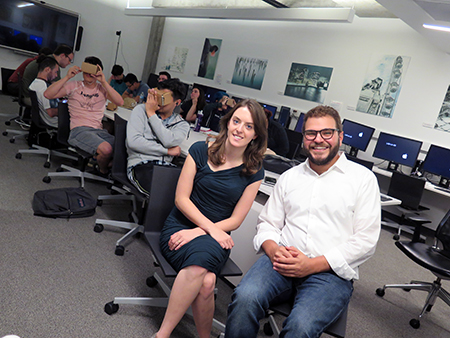
Sarah Berkovich '10 and Barry Pousman ’06. Photo/Daryl Paranada
In a presentation during the showcase, Berkovich talked about the impact that VR can have on social causes. She used Clouds Over Sidra, a 2015 VR film about the Syrian refugee crisis co-directed by alumnus Barry Pousman ’06, as an example. Used in United Nations Children’s Fund street campaigns, the film helped change the engagement rate from one-in-twelve to one-in-six. Berkovich also spoke about key takeaways that students learned through the class. These include: VR is not the same as film and should be thought of differently, take pre-production seriously, and keep the issues big and the stories small.
“VR is a felt medium,” said Berkovich. “Emotion is everything and you can use a lot of tools to convey emotion.”
For Slum Visions: A Film2Future Story, Jason Blanton ’18 worked with Andrew Arias to show the Angeleno photographing graffiti and other parts of LA as he describes his life growing up and his interest in photography.
“I’m just surrounded by a bunch of bad stuff and make it look good,” said Blanton in the video. “I grew up around gangs, graffiti, stuff like that, so for me I just found [photography] as an outlet to escape that world and just photograph it.”
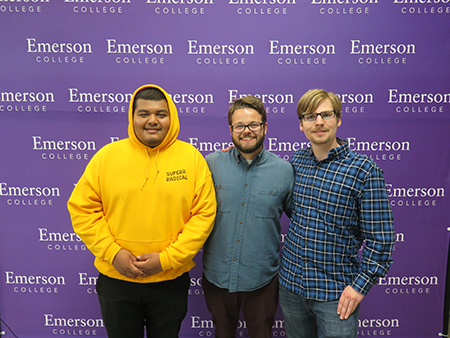
Andrew Arias, Jason Blanton '18, and Kieran McKeon '18. Photo/Daryl Paranada
The video describes the impact that Film2Future has had on Arias’s life and explains what the nonprofit does. Blanton said one of his favorite aspects of making the film was seeing it come together.
“We had a chance to make an impact piece with a great message,” said Blanton. “It was really cool seeing how powerful the piece we were making could be.”
Students who participated in the Virtual Reality for Social Change class say that they are now open to working in VR. Before the class, Mustari had never done anything in the VR field. Now,
“I wouldn’t have considered working in VR at all before this class,” said Mustari. “I feel like VR is such an untapped industry right now. There are so many opportunities.”
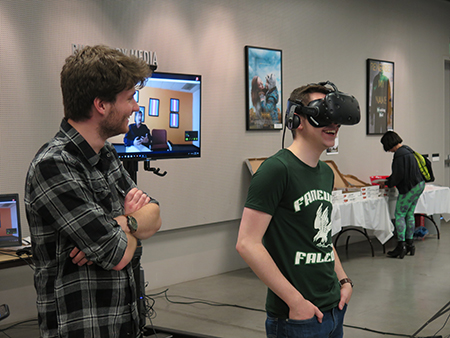
Chance Molenda '18 watches as Michael Kiaunis '18 enjoys his VR film. Photo/Daryl Paranada
Categories